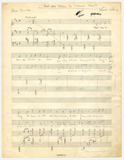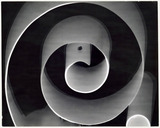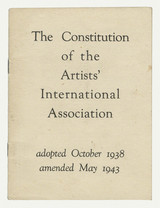Kurt Schwitters: Untitled (portrait of Fred Uhlmann) (1940)
While detained at the Hutchinson Internment Camp on Isle of Man, jokingly nicknamed the “artists camp” due to the great number of artist detainees, Kurt Schwitters met a host of like-minded characters. The majority of the internees were displaced Germans and Austrians or other opponents of the Nazi regime.
Kurt Weill: And What Was Sent to the Soldier’s Wife?, song (1942)
The composer Kurt Weill, in exile in the US, set Bertolt Brecht’s poem And What Was Sent to the Soldier’s Wife? to music for singing voice and piano. The seven verses describe the things that a soldier sends to his wife from various stops.
László Moholy-Nagy: Letter to Paul Citroen (1936)
László Moholy-Nagy enjoyed a productive phase in the summer of 1936. A number of orders for film and photojournalistic essays such as "The Street Markets of London" gave him a measure of financial stability.
László Moholy-Nagy: photogram untitled (1943)
László Moholy-Nagy started working on photograms in the 1920s. In his book vision in motion (1946) the artist describes the technique.
Lea Grundig: Blick auf den Hafen von Haifa von der „Patria“, graphic (View to the Harbour from the Patria, 1940)
The sinking of a refugee shipThe artist Lea Grundig did not want to go into exile in 1939 but she was deported by the Nazi authorities. She began an odyssey through Europe that finally ended in 1940 on the refugee ship SS Pacific in the sea off Palestine (in Haifa).
Lea Grundig: Flüstern und Lauschen, etching (Whispering and Eavesdropping, 1936)
This etching – titled Flüstern und Lauschen (Whispering and Eavesdropping) – is from the 20-part series Unterm Hakenkreuz (Under the Swastika) (1936) by the artist Lea Grundig. In this work she depicts the conditions of life under the Nazi dictatorship.
Lea Grundig: Night in the Atlit Camp, watercolour (August 1941)
Working as an artist in the Atlit detainee campThe artist Lea Grundig reached Palestine in November 1940 as a survivor of the shipwrecked SS Patria and thus as an illegal immigrant. The British Mandate government interned her in the Atlit detainee camp.
Leaflet: Derby International Centre (c. 1943)
The Derby International Centre was founded in 1943 in the English city of Derby, home of the Rolls Royce automobile and aircraft plants which were crucial to the British war effort. Theo Balden established it as a kind of new version of the "Oskar Kokoschka Bund" in Prague.
Legal charter of the Artists' International Association (c. 1943)
Founded as an association of artists committed to international artist cooperation and to peace and democracy, the Artists' International Association (AIA) organised exhibitions. The 1937 exhibition Twentieth Century German Art featured works by exile artists living in the United Kingdom; it thus served as a counter-exhibition to the Nazi propaganda exhibition of Degenerate Art.
Leo Maillet: Ganz Ohr [All Ears], etching (1982)
The broken faceSelf-portraits were a prominent part of painter Leo Maillet’s oeuvre during the period from 1940 to 1945. These works mostly took the form of small-format drawings and watercolours.










![Self-portrait: Leo Maillet, Ganz Ohr [All Ears] Self-portrait: Leo Maillet, Ganz Ohr [All Ears]](/KIE/Content/EN/Images/objects/maillet-leo-selbstportrait-en.jpg?__blob=thumbnail&v=4)
